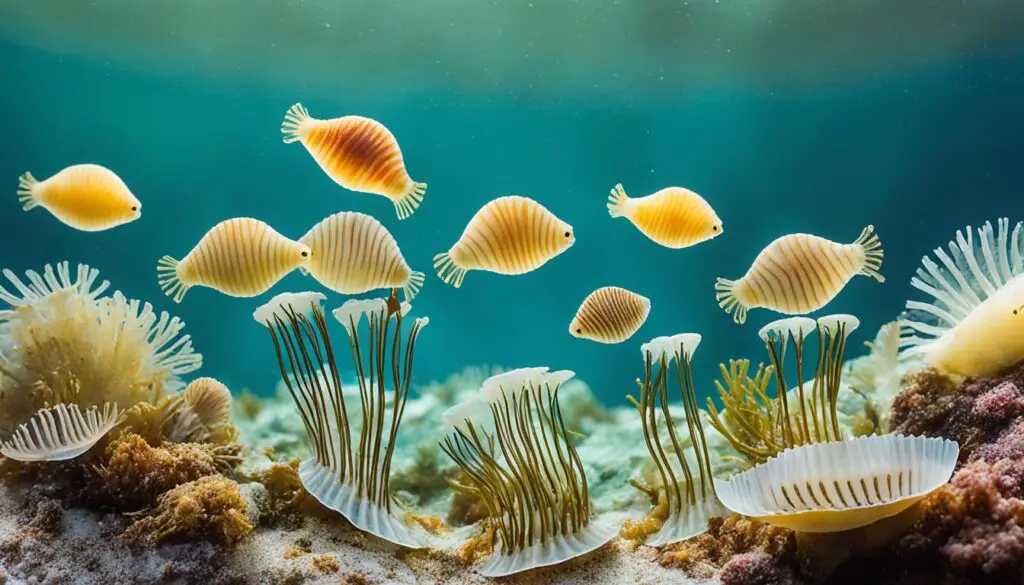Scallops are fascinating marine creatures that are crucial to the ocean’s balance. You might ask, how do scallops reproduce? They reproduce through a unique process where both males and females release their gametes, or sperm and eggs, into the water. This method is key to keeping scallop populations healthy and maintaining the ocean’s health.
Learning about their life cycle shows us how important scallops are to the ocean. It also highlights their ability to adapt to different environments. By understanding scallop reproduction, we can see their role in the ecosystem and how they survive.
Understanding Scallop Reproductive Organs
Scallops have a unique way of reproducing, which is vital for their survival and growth. Their reproductive organs play a big role in this process. These organs help scallops reproduce in different water environments. They can be identified by their unique features and where they are in the scallop’s body.
Female and Male Gonads
It’s easy to tell the difference between female and male scallop gonads. Female scallops have bright red gonads, while males have creamy white ones. This makes it simpler to identify them during the breeding season. Scallops can even have both female and male organs, showing how adaptable they are to their surroundings.
Location of Reproductive Organs
The reproductive organs of scallops are found in the visceral mass, inside the shell. This spot is perfect for the spawning process because it ensures good water flow over the gonads. This increases the chances of successful fertilization, showing how advanced scallop reproduction is.
| Characteristic | Female Gonads | Male Gonads |
|---|---|---|
| Color | Bright Red | Creamy White |
| Location | Visceral Mass | Visceral Mass |
| Reproductive Structure | Can be both | Can be both |
The Scallop Reproduction Process
The scallop reproduction process is truly amazing. It shows how nature works in complex ways. By learning about scallop spawning, we see how they live and produce many eggs. These marine animals have special ways to survive, even when many of their young don’t make it.
Spawning Behavior and Timing
Scallops spawn in spring and fall, when the temperature changes. Female scallops release their eggs into the water at the same time as the males release sperm. This timing helps increase the chances of fertilization. It’s a key part of scallop reproduction.
This method works because many gametes are released at once. This increases the odds of successful reproduction.
Massive Egg Production
Female scallops can produce up to 270 million eggs in one spawning event. This shows how important reproduction is for scallops. Even though not all eggs will grow up, this shows scallops’ determination to keep their species going.

How do scallops reproduce?
Scallops have unique scallop breeding habits. They use a method called external fertilization. This means they release eggs and sperm into the water at the same time. This helps mix the gametes for fertilization and keeps scallop populations diverse.
Scallops, like bay scallops, usually spawn in the fall. This timing is key for successful fertilization and getting larvae into the ocean. It helps increase the chances of survival for the next generation.
Knowing how scallops reproduce is crucial for their conservation. It helps them adapt to changes in their environment. This is because reproduction and genetic diversity are key to their survival.
Scallop Fertilization Strategies and Life Cycle
Scallops go through a unique journey from fertilization to maturation. They have special strategies to keep their species going in different marine places.
Fertilization Rates and Challenges
Fertilization rates for scallops are very low. Only one egg out of about 12 million might make it to adulthood. This means there are many challenges.
Things like water temperature and salinity affect fertilization success. Also, competition with other sea creatures and being eaten by predators makes it hard for scallops to survive.
Stages of Larval Development
After fertilization, eggs turn into tiny larvae called veligers in about 36 hours. These veligers float in the water for 10 to 14 days. They eat and grow, getting ready for life.
Then, they settle on the ocean floor and turn into young scallops. The timing of these stages depends on the environment. This shows how important stable homes are for young scallops to survive and grow.
Impact of Environmental Factors on Scallop Reproduction
Scallops’ ability to reproduce is greatly affected by the environment. This includes water temperature, salinity, and where they live. For example, the right water temperature helps scallops spawn well, keeping their numbers strong. But, very hot or cold water can mess up their breeding, leading to fewer scallops.
Habitat conditions are also key for scallop reproduction. If the area where they live changes, like less seagrass or shifting sand, it can hurt their numbers. Scallops need a stable place to grow and reproduce. Changes in their home can threaten their survival.
Keeping scallop habitats safe is important for their numbers and fishing. Knowing how the environment affects scallops shows why we must protect the ocean. By looking after these delicate places, we help scallops and all marine life.
FAQ
How do scallops reproduce?
Scallops reproduce through a process called spawning. Both males and females release sperm and eggs into the water. This helps with fertilization.
What are the reproductive organs of scallops like?
Female scallops have bright red gonads, while males have creamy white ones. This makes it easy to tell them apart during spawning. Their organs are in the visceral mass for better water flow during fertilization.
What triggers scallop spawning behavior and timing?
Spawning happens in the spring and fall, triggered by temperature changes. This timing is key for successful reproduction.
How many eggs can a female scallop produce?
Female scallops can release up to 270 million eggs at once. This shows their huge reproductive potential, even with many eggs not surviving.
What are scallop fertilization strategies?
Scallops use external fertilization. They release gametes into the water together. This leads to a wide genetic diversity, helping them adapt to changes in their environment.
What challenges do scallops face in their fertilization rates?
Only about one egg in 12 million survives to adulthood. Environmental factors greatly affect these survival rates, impacting scallop populations.
Can you explain the stages of larval development in scallops?
After fertilization, eggs turn into tiny larvae called veligers in about 36 hours. These larvae float in the water for 10 to 14 days. Then, they settle on the ocean floor to become young scallops.
What impact do environmental factors have on scallop reproduction?
Scallops are sensitive to changes in water temperature, salinity, and their living space. Issues like seagrass decline can hurt their spawning and growth, threatening their numbers.







